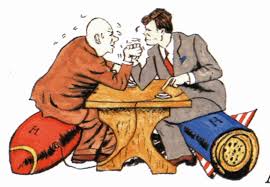
Observers speak of the “New Cold War” as a self-evident and incontrovertible reality. Already in the spring, the new contours of international politics, demarcated by sanctions and mutual rhetorical incursions, were fully recognized by the broadest segments of the public in Russia, Europe and the United States—including those who were very far from decision-making processes—as a return to the familiar and frightening principles of the second half of the twentieth century.
Nearly seven decades ago, these principles were first spelled out by the ruling elites and then established themselves on all levels of society, from the consciousness of intellectuals to the everyday practices of the majority. In society’s perception, the reality of constant psychological mobilization and the tense expectation of global military conflict became a way of life to be reproduced by two generations, for whom fidelity to convictions was always inextricably linked to fear and the feeling of powerlessness in the face of fate. The unprecedented destructive power of the new super weapons has had a disarming effect on both sides of the invisible front, whose strength can now only be measured in its capacity to make people accept choices that have already been made for them in advance. Paradoxically, the constant feeling of risk has proven to be one of the most stable conditions of recent modern history, which is why its memory has always prompted so much subconscious nostalgia.
In our days, the specter of the Cold War has returned, and it has roused not only old-school diplomats, but generals, and/or propaganda hacks who finally feel that they are once again on more solid ground. The situation of an imposed choice between two “camps” is obviously no less fascinating to those who customarily think of themselves as attentive critics of any ideological construct. Identification with one of the conflicting sides appears as an intriguing solution to the general intellectual identity crisis of the last two decades. At the first unconfirmed signals of an old-new Cold War, intellectuals are ready to take a position at a moment’s notice and bring clarity to lines of conflict that, in fact, have not yet taken on their final contours. If the first Cold War began with military and political decisions that only subsequently found ideological form (Hiroshima preceded the Fulton speech), in its current, nostalgic repetition, the events on the ground are trailing the production of rhetoric.
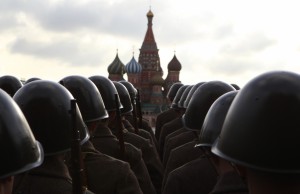
The Cold War and Soviet Intellectuals
This change in sequence points toward the profound transformation of the intellectual’s position at the time of the real Cold War that has long since ended. On the cusp of the 1940s and 1950s, there was a fundamental change both in the USSR and the West, despite all external differences. Namely, intellectuals were no longer just a group that was capable of crafting ideology on commission. Instead, they became a group that was always ready to commission, refine, and reproduce ideology all on their own.
The Soviet Thirties and their politics of endless international zigzags were accompanied by repressions that ultimately produced flexible, cynical, and permanently terrified ideologues, each at the ready to defend positions that he or she was denouncing only yesterday. First, fascism was little more than an insignificant obstacle on the road to global revolutionary crisis (from 1928 to 1934); then it became the main threat to democracy and progress (until 1939), and then it disappeared entirely from propaganda after the Molotov-Ribbentrop Pact, only to return as the main enemy after Germany’s surprise attack on the USSR.
These head-turning twists of foreign policy set in motion a ceaseless mechanism of selection, the only survivors of which were ideological “minutemen,” always ready for the most unexpected change. Permanent disorientation and instability gave rise to a new breed of propagandists who had learned never to trust anyone—especially not themselves.
The onset of the Cold War and the imperial-chauvinist turn of Soviet domestic policy in the late 1940s, on the contrary, created points of orientation that would remain constant through the entire post-war period of Soviet history.[1] The coexistence of two world systems that were constantly on the brink of global military conflict had become a reality, and it determined the consciousness of the Soviet intelligentsia for decades. The rise and fall of escalation and “detente” were little more than different symptoms of a reality that would never undergo any fundamental changes. The borders created by a confrontational foreign policy shaped all major subjects of public discussion: be it the debates on the future of the scientific-technological revolution or on that of “socialism with a human face” in the 1960s,[2] or in the heated dissident discussions on the balance of nationalist and humanist-universalist values in the 1970s,[3] the background was always the same, its horizon set by the front lines of the Cold War. To take any “third position” of political or cultural self-determination to elude the brutal binary structure of the conflict between East and West seemed so obviously impossible that it required no special confirmation from above. In that way, any opposition to “really existing socialism” was identical to a conscious choice in favor of what was considered “the other side”: the West.
Over the last two decades of the existence of the USSR, official “Marxism-Leninism” was already hopelessly discredited, creating the need for an ideology capable of organizing society and legitimating power in its place. The first de facto replacement was the “revolutionary-imperial paradigm,”[4] in which the idea of opposition to the West gradually became organically connected with a fear of disrupting the fragile global balance of power. It is indicative that the existence of this “military” stability chronologically coincides with the total domination of the country’s leadership by a generation whose political ascent began in the late 1940s. The utter defeat of Gorbachev’s “Perestroika” was in many ways connected to the radical reassessment of the highly-complex construct of all the domestic and international relations that had emerged over preceding decades of the Cold War. Clearly, the ensuing dissolution of the USSR, the victory of “democratic forces” and the beginning of the traumatic transition to the free market meant that one of the two warring sides had won.
One could say that that the Cold War’s main appeal to society lies in the radical reduction of a huge variety of conflicts into one central conflict capable of explaining all contradictions. This reduction is in fact what lies at the base of global Cold War ideology, beyond all the arbitrary fronts.
Then again, the Cold War did not only consolidate the elite, guarantee the loyalty of the majority, and create conditions for US hegemony in Western Europe. It also allowed the political left to become an organic part of the system. The very possibility for criticizing this system from within then became a source of strength and a competitive advantage. In that sense, the Cold War created a new language of universal values, in which the strength of each side mirrored the enemy’s weaker points. Using values such as personal freedom, democracy, and human rights as weapons, the West finally seemed on the verge of turning all those Enlightenment abstractions into flesh and blood, giving them a proper grounding.
The two “hot” global conflicts preceding the Cold War had created the problem of millions of “stateless persons,” for whose basic rights there were no guarantees from the sovereignty of any state or membership in any national community. “The Rights of Man, supposedly inalienable, proved to be unenforceable—even in countries whose constitutions were based upon them—whenever people appeared who were no longer citizens of any sovereign state. […] Nobody had been aware that mankind, for so long a time considered under the image of a family of nations, had reached the stage where whoever was thrown out of one of these tightly organized closed communities found him [or her] self thrown out of the family of nations altogether.” (Hannah Arendt, Origins, 293‒294). In that way, the only subject to guarantee human rights was an unrepresented “humanity,” and it lacked a political body as well any other form of sovereignty. For Hannah Arendt, this catastrophe of human rights appeared as one of the necessary components in the drama of European totalitarianism.
In practice, the Cold War was a unique historical example for how an abstract “humanity” gained a voice and real power in the person of a summary “Western World,” with the USA as its flag-holder. An example for how the defense of political rights appeared as an unconditional priority was the campaign for the free emigration of Soviet Jewry and its culmination in the Jackson-Vanik Amendment to the American-Soviet Trade Agreement. The community of human rights activists to emerge in the late 1960s and early 1970s quickly moved from ethically objective declarations on “rights” meant to triumph in principle to rights whose weight was constantly confirmed in appeals to the military-political bloc who would back them.
Just as the universal right of nations to self-determination became a weapon of the “socialist camp” with the onset of decolonialization in the countries of the Third World, so were the universal rights of man privatized by the “free world.” Incidentally, the “socialist camp’s” main gain in the field of universal rights was still the right to revolt. Historical irony has it that this right would have become a universal even without the American Declaration of Independence. Each human right that formerly seemed neutral had now gained a motherland and an unprecedented possibility for historical realization, albeit in exchange for its own universality. According to the same iron logic, the struggle for the rights and freedom of political prisoners became something of a POW-exchange between two sides of an undeclared global war.
Once the confrontation had moved from the military field to that of values, culture inevitably became one of its chief battlegrounds. On this front, too, the balance of power had shifted by the mid-1950s and overwhelmingly remained in favor of the West, which seemed able to use any individual expressions of creativity, no matter what their quality. That is where one finds the most terrifying achievement of America and its apparatus for the propaganda of universal meaning at the time of the Cold War: all claims of “independence,” escapism or positions above and beyond the struggle worked in its favor.
The Cold War saved the USSR from the erosion of its dominant ideology, a process that began toward the end of Stalin’s reign. In the United States, this construct was the result of a convergence and an amalgamation of a paradoxical, eclectic, and still remarkably viable coalition. It included political and social groups that had never historically been allies, bringing together conservatives, Christian fundamentalists, Roosevelt liberals, so-called “non-communist leftists,” Ivy League graduates and Eastern European immigrants. All the contradictory forces of a society that had only just survived the deepest of crises in the Great Depression now found themselves part of a unified front reaching far beyond America’s borders.[5] This coalition was far from organic; its creation was dictated by the necessities of foreign policy and was the result of special efforts from above (through the secret services or think tanks with ties to the government). Yet it generated an elastic and unbelievably robust language for the public discussion of foreign policy.
The Triumphant Return of Cold War Language
Recent events show that neither the language of the Cold War nor the desire for clear and simple lines of self-definition has receded into the past. Instead, they are reproduced by intellectuals independently, at the first unconfirmed hint of a return to the situation of a “war of the worlds.” As soon as the signal was heard, the first necessary stage of work commenced, namely to update the vocabulary of a universal notion that would later become the vocabulary of war. Obviously, “Europe” is the crucial term in such a vocabulary. Of course, intense ideological work in constructing “Europe” was ongoing for most, if not all, of the European Union’s history as the project of its political elites. However, over the last years, the very crisis of that project has activated the entire diversity of its inner contradictions, significantly undermining the legitimacy of any intellectual activity linked to its historical universalization.
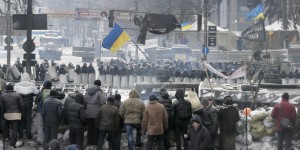
It only took a few weeks for the Maidan in Kyiv to evolve from a limited movement in support of an association with the EU to a full-fledged political revolution. In the international context, however, the Maidan’s political meaning is consistently and even doggedly interpreted as a particular (albeit heroic and inspiring) case of the struggle for “European values.” As early as January, when the political perspective and the contours of the Maidan were not yet certain, a group of intellectuals including Slavoj Zizek and Carlo Ginzburg published a collective letter in support of the Maidan as a movement capable of reclaiming the project of a united Europe, giving it back some of its lost significance and high-mindedness.[6]
The well-established Enlightenment figure of the “noble savage” gains a new meaning in the image of the distant Ukrainian whose blood sanctifies tarnished European ideals that have been long since forgotten and rejected by their original inventors. It is important that this voice in support of the “European choice” came from the political left, which in the critical moment discovered in itself no less passion for familiar, simple schemes for interpreting events than the Cold Warriors of the political right, who also enthusiastically set about pulling the old propaganda weapons out of their rusty sheathes.
It does not take much time to install the stage set of a “war of the worlds” when we draw upon the inexhaustible resources of historical imagination. One can safely say that at present this work is almost done. The Right is in the electoral avant garde, and part of the Left is not far behind.
The Russian side’s most noticeable and consistent representative is without doubt the philosopher and essayist Alexander Dugin, who had already pioneered the notion of “conservative revolution” in the post-Soviet context twenty years ago. For Dugin, the annexation of Crimea and the events in Eastern Ukraine are the consummation of “Russia’s return to history.” In a recent programmatic text, he describes these ongoing events as the final climax in Putin’s reign, whose figure symbolizes the struggle for the material legacy of the geopolitical capitulation in the 1990s and the mystical “second body of the king,” thereby claiming a genuine sovereignty to overcome the moribund hegemony of American civilization.[7]
Furthermore, Dugin’s neo-Eurasian project finds its near-symmetrical counterpart in the approach of the liberal-conservative historian Timothy Snyder, who recently held a lecture in Kyiv entitled “Ukraine and Europe.” According to Snyder, Ukraine’s inevitably European future is completely pre-determined by its European past. From the foundation of Kyivian Rus’ by the Vikings (“a typically European history”) to the transformation of its legacy into the Polish-Lithuanian Commonwealth, Ukraine constantly proved that it belonged to Europe, as if it had been making unconscious choices at each moment of its history that would be obvious to any European country. Just as the new members of the EU rediscovered their roots in the 2000s, as if awakening from a deep sleep to come home to the family of nations like prodigal sons, Ukraine today is experiencing the tortuous but inevitable rediscovery of its own European nature.
On the path of this return to a genuine, pluralistic Europe capable of healing all historical wounds, there is an obstacle: Russia, which today presents a distillate of the “anti-European” project. According to Snyder, Putin’s “Eurasian project is precisely to make Europe—the whole of it—look like Ukraine does now: that is, alone, without enough friends who understand it; fragmented; intervened in from the outside.” Between Europe and anti-Europe, there is no leeway for choice: “There is a Eurasian future that you can all go into together, and there is a European future… there isn’t anything else.”[8]
Both of these constructs are identical in the fatality of their choices and the impossibility of any “third position,” no matter what its source or legitimations. The grand style of the Cold War overtakes any immediate armed confrontation in order to confirm the logic of combat as a constant state of society. The Cold War’s atmosphere is characterized by constant gymnastics of military morale, and takes the right to doubt away from intellectuals—that is, from those whose doubt is a crucial element of their professional vocation and political function alike.
There is thus a touching confluence between Alexander Dugin and Timothy Snyder as they stage a “clash of civilizations.” There is nothing very surprising in this dramaturgy, in itself a near-traditional right-wing sport. Every time a trans-historical enemy appears on the horizon to threaten “our” culture and values, it is an act of divine providence, capable of reviving a morally decrepit, demobilized nation by imbuing it with the necessary vitality and unity. It is enough to remember how some conservative commentators in America interpreted the terrorist attacks on the World Trade Center on September 11th, 2001, little more than a decade ago.
Forced to Choose
If for the Right, the logic of the Cold War entails the return of a lost historical optimism and brings up the long-awaited identity between nation and state, for the Left, on the contrary, it narrows the questions at hand, which no longer concern grand emancipatory projects, down to problems of personal choice. Unlike the Right, whose understanding of history unexpectedly becomes the only legitimate means of describing reality, the historical perspective of the Left suffers an overwhelming defeat. Never before, other than at the peak of the Cold War in the 1940s and 1950s, have leftist intellectuals felt so alienated from the process of history, whose moving forces have now fully lost any human features.[9] Such was the case of Arthur Koestler, who at that time had arrived at the end of his meandering drift from the Stalinist Comintern to a brutal anti-communism, and wound up predicting the imminent end of civilization at large.[10] In his novel The Age of Longing (1951), he paints an apocalyptic picture of Paris on the brink of an inevitable invasion by the Soviet hordes, culminating in nuclear war. However, the main reason for the end of the West, according to Koestler, is that the absolute majority of intellectuals are ready in principle to capitulate, having been turned into Stalinist zombies. One of the characters of the novel, a famous Soviet writer visiting the French capital as the honorary delegate of yet another “Congress in Defense of Peace” staged by the Kremlin, decides not to return home. He flees the realm of necessity to find himself anew and to achieve the genuine meaning of creativity, though actually, there is nowhere left to run.[11]
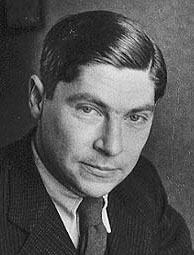
Koestler was to become one of the most striking representatives of the “non-communist left,” an incredibly active network of intellectuals for whom the next consistent step in the rejection of Stalinism would be collaboration with the CIA. Koestler joins other former communists as one of the authors in the anthology The God That Failed, published with the active support of the American secret services, around the same time that another disappointed leftist, George Orwell, published his blockbuster 1984.[12] Koestler and his co-authors do not attack or oppose Stalinism with any other grand political project as an alternative; they only seek to reinstate the right to make choices that Stalinism had trampled. As the former participants of emancipatory mass movements sift through the ruins, they have no choice but to fight for their right to be themselves; to retain a possibility for critical thinking and dissent. In this fight, they could count on the support of only one of the Cold-War camps.
Jean Paul Sartre, Koestler’s interlocutor in Paris in the 1940s, had similar experiences, but came to exactly the opposite conundrum. By the 1950s, his search for an independent emancipatory and anti-authoritarian position led him to see the necessity of supporting the Communists. Later, describing his position, Sartre tells of how he had to leave his position as a powerless yet morally impeccable “lovely clean little atom,”[13] unsettled at first by the experience of German occupation and anti-fascist Resistance, and later, the political opposition between two camps, drawing a decisive line not only through all national politics, but through anything at all, no matter how small, including the personal friendship of the community. Sartre’s programmatic individualism and his suspicion of any political representations generated a lasting mistrust among the French Communists. However, paradoxically, Sartre could only fully express his individuality in an alliance with frightening collectivist monoliths such as the French Communist Party:
During this time I thought about what I’d do in [the] case of a conflict between the US and the Soviets. I said that the PC seemed to me to represent the proletariat. It seemed impossible to me not to be on the side of the proletariat. In any event, the recent history of the RDR had taught me a lesson. A micro-organism that aspired to play a mediating role rapidly decomposed into two groups: one pro-American, the other pro-Soviet. Before the threats of war which, around 1950‒1952, seemed to be growing from day to day, it seemed to me that only one choice was possible: either the USA or the USSR. I chose the USSR.
The choice between two hostile camps was a trauma, and one that has yet to be overcome, it seems. Again and again, it raises its head, under transformed conditions, which are more of a farce than a tragedy. Unlike the real Cold War half a century ago, the present conditions are not forcing anyone to write aggressive columns against “Putin’s useful idiots” or opposing the supporters of the “Nazi-Maidan.”[14] In the thrall of some monstrous inertia, they are ready to make that false choice for themselves. Intellectuals were one of the victims of the Cold War of the last century, which taught them to come to terms with their own powerlessness and equate their truthfulness to themselves with loyalty to one of the belligerent sides. What is happening today seems infinitely removed from the substance of the twentieth-century conflict between the USSR and the West. But clearly those used to the production of ideological forms feel comfortable only returning to those old, well-rehearsed roles.
The last Cold War gave us what were probably the most cynical and artfully manipulative examples of realpolitik ever, and as we know, Stalin was one of its main virtuosi. This cynicism was poisoning the entire world, but instead of engaging in its ruthless critique, traumatized intellectuals would further justify it with all the strength of their sincerest passion. If the Cold War really is back, we now have a chance not to play the same role again.
Translated by David Riff. The original version of this text appears in the Issue #18 of Manifesta. The author would like to thank Ilya Matveev for the valuable remarks and suggestions, which have helped improve this text.
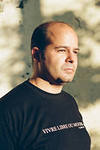 Ilya Budraitskis (1981) is an historian and a cultural and political activist. Since 2009 he is a Ph.D. student at the Institute for World History, Russian Academy of Science, Moscow. In 2001-2004 he organized Russian activists in mobilizations against the G8, in European and World Social Forums. Since 2011 he has been an activist and spokesperson for the Russian Socialist Movement. A member of the editorial board of “Moscow Art Magazine,” he is a regular contributor to a number of political and cultural websites.
Ilya Budraitskis (1981) is an historian and a cultural and political activist. Since 2009 he is a Ph.D. student at the Institute for World History, Russian Academy of Science, Moscow. In 2001-2004 he organized Russian activists in mobilizations against the G8, in European and World Social Forums. Since 2011 he has been an activist and spokesperson for the Russian Socialist Movement. A member of the editorial board of “Moscow Art Magazine,” he is a regular contributor to a number of political and cultural websites.[1] This thesis is detailed, for example, in the book: A Failed Empire: The Soviet Union in the Cold War from Stalin to Gorbachev (The New Cold War History) 2007, University of North Carolina Press
[2] Probably key programmatic text in this discussion – Andrey Sakharov’s Progress, Coexistence and Intellectual Freedom (http://www.sakharov-center.ru/asfconf2009/english/node/20)
[3] This central debate for the dissident milieu of 1970th was reflected in two Russian-language anthologies: From under the Rubble edited by Alexander Solzhenitsyn (IMCA-PRESS, Paris, 1974) and the collective answer to it by a number of liberal and socialist dissidents in Self-conciseness (Khronica, N.-Y., 1976).
4 Definition from Zubok’s A Failed Empire: The Soviet Union in the Cold War from Stalin to Gorbachev (Moscow: ROSSPEN, 2011).
[5] This turn of the Western intellectuals was perfectly described in Frances Stonor Saunders. Who paid the piper: CIA and the Cultural Cold War. Granta Books, London, 1999.
6) http://www.theguardian.com/world/2014/jan/03/support-ukrainians-build-fairer-europe, last accessed 23 September 2014.
[7] Alexander Dugin. Vladimir Putin’s second body http://evrazia.org/article/2536
[9] The most merciless diagnosis of the degradation of American leftist intellectuals could be found in C. W. Mills’ essay “Powerless People: the Role of Intellectuals in Society” (1944). It is rather telling that some of the protagonists of this text—Sidney Hook, Arthur Koestler, and Dwight MacDonald—would soon become exemplary Cold Warriors.
http://magazines.russ.ru/nz/2014/2/10r.html
[10] A more detailed account of Koestler’s evolution over this period could be found in the following chapter of M. Ulyanovskaya’s book Freedom and Dogma. The Art and Life of Arthur Koestler. http://www.jewniverse.ru/RED/Ulanovskaya_Koestler/coldwar_woriar.htm
[11] Arthur Koestler. The Age of Longing. Arthur Koestler. Macmillan, 1951
[12] The God that failed. New York : Harper, 1949
[13] https://www.marxists.org/reference/archive/sartre/1972/compagnon.htm, last accessed 23 September 2014.
[14] Clear example of this polarization: Slawomir Sierakowski. “Putin’s Useful Idiots.” http://www.nytimes.com/2014/04/29/opinion/sierakowski-putins-useful-idiots.html


One reply on “Intellectuals and the “The New Cold War”: from the Tragedy to the Farce of Choice”
One difference between the old and the new Cold War is that in the old Cold War substantive differences between the two sides in real social relations made it possible to think up coherent rationales for supporting one side or the other. What differences are there between the two sides today? Oligarchical capitalism and “managed democracy” prevail on both sides. National prejudices seem to be the only factor determining how people choose between them.
Likewise, anti-fascism provides no guidance in choosing sides because while neither side can be unequivocally described as fascist there are certainly strong fascist tendencies on both sides and outright fascists have played prominent roles on both sides.